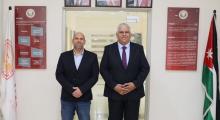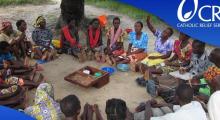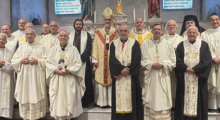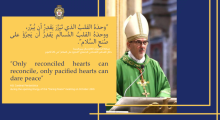Issued by the Catholic Center for Studies and Media - Jordan. Editor-in-chief Fr. Rif'at Bader - موقع أبونا abouna.org
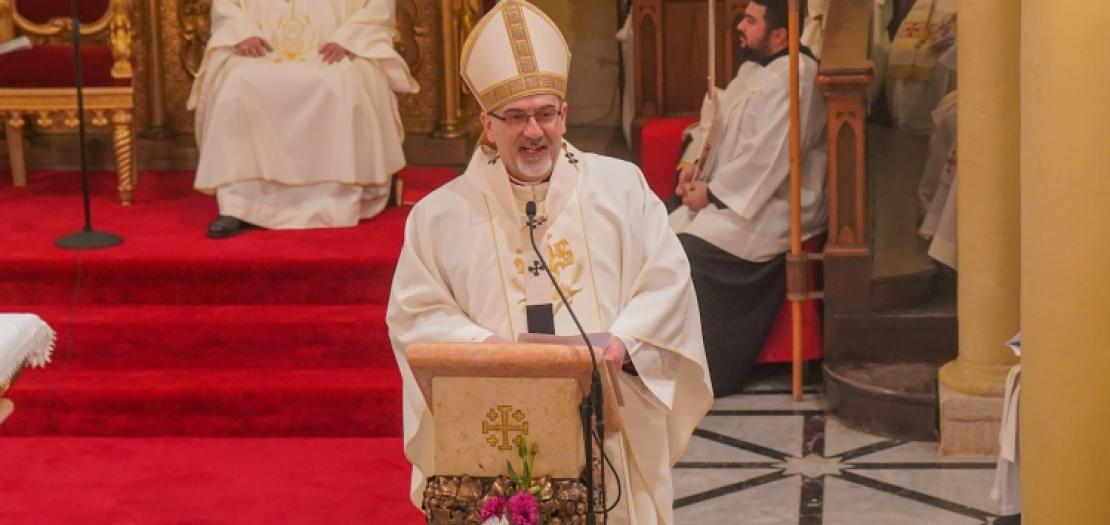
Following is the text of the homily by Cardinal Pierbattista Pizzaballa, Latin Patriarch of Jerusalem, on the Feast of the presentation of Jesus in the temple- Day of Religious Life, dated February 2, 2025:
Dear brothers and sisters,
May the Lord give you peace!
Our Church is generally remembered and mentioned as the Church of suffering and Calvary, of difficulties and divisions. This certainly has its share of truth. Indeed, one cannot be in Jerusalem without experiencing Calvary. Preserving the places of the human experience of Christ, also means making this experience our own, and Calvary is certainly close to us and we feel it in our daily difficulties. In this last year of war, we have experienced this aspect with an intensity that we have never seen before. As the Psalm says, it seemed to us to “dwell in darkness and in gloom, prisoners in misery and in irons.” (Psa. 107,10) But in this year dedicated to hope, let us also reaffirm our faith in the God of life, who in Christ has brought us out of darkness and the shadow of death and breaks our chains. (cf. Sl. 107:14)
And on this day dedicated to religious life, I really want to emphasize the other face of our Christian life in the Holy Land. The face of those who, despite everything, by your presence continue to be “lamps shining in the night” and “seeds of goodness in a land rent asunder by conflict”, as the Holy Father told us a few months ago. It is your presence that above all makes the style of Christian life visible in this Holy Land. An open-minded style that places itself at the service of all men and women in this country. And I would like to thank you for that.
It would indeed be unjust and a serious lack of faith if we were to limit ourselves to withdrawing into our own wounds, to look at our own pain without looking up and seeing first and foremost the pain of others and not just our own, but also recognizing how the Spirit continues to inspire initiatives of life, solidarity, hope and future within our Church too.
The numerous religious institutions, which are proportionally far more numerous than the actual number of Christians in the Holy Land, are a clear sign of vitality. There is indeed a religious presence in our small ecclesial community that is an expression of the diversity of languages and charisms present in the rest of the universal Church. A religious presence that, together with the parishes and local communities scattered throughout the territory, plays a fundamental, I would say indispensable, role in giving our Church a precise shape and identity. In fact, the religious presence covers all aspects of the lives of men and women in the Holy Land. It takes care of the weaker segments of the population (children, the disabled, the elderly, families with problems, etc.); the education and formation of the local youth (schools and universities); the welcoming of pilgrims from all over the world (Holy Places); the study and the love of the Word of God (Bible centers); the study and theological formation of religious from and for the whole world (theological studies), but also for the local faithful; contemplation and spiritual life (contemplative monasteries) and much more.
These are the ways in which the Church of the Holy Land brings the Christian witness to life in this tormented land. The Gospel we have heard speaks of light (“light for revelation to the peoples.” ( Luke 2:32) It is our way to reveal our love for Christ in this country, and we are making it possible, thanks to you. I thank you for that.
I would like to focus on just two passages from the proclaimed Gospel, which, when we hear it, is still provocative, even though we all know it very well.
The first element concerns the presence of the Holy Spirit, who is the real protagonist of this passage.
We found this in relation to Simeon, but the Spirit forms the background to the whole passage: “The Holy Spirit was upon him” (Luke 2:26), and he had foretold him that he would see the Messiah (Lk 2:26). Moved by the Spirit, he goes to the temple that day (Luke 2:28) and recognizes in the child the redemption he has been waiting for. (Luke 2:29-32)
The temple was undoubtedly one of the busiest places in the city, full of people and life, and Joseph and Mary were mixed and confused with many others in the crowd. Therefore, no one - except the two elders - could notice their presence. Absorbed in their occupations, they did not realize that the consolation and salvation passed through their midst. Their hearts were not vigilant and expectant. In fact, the Gospel explicitly states that Simeon was waiting for the consolation of Israel (25). When you are waiting for something or someone, you are also alert for the signs that indicate their arrival. If you are not waiting for anyone or anything, you are not even interested in looking for signs. Moreover, the Gospel does not speak of waiting in general, but of a waiting that is enlightened by the Holy Spirit, who makes it possible to see the signs of God’s work. It was this that enabled the two elders to recognize and celebrate in this child the salvation and consolation they were waiting for.
Our whole Christian life is nothing other than waiting to encounter the Lord, to recognize that He is present and at work in our lives and in the world. And never has it seemed so difficult for us to recognize the fruitful presence of God among us as it is today, especially in the face of the tragedy that the Holy Land is experiencing. Reversing the question of God in the Garden of Eden, it comes more naturally to us to turn to God and ask: “Where are you?”
I am more and more convinced that the contribution that religious life should make to our Church in the Holy Land is precisely this: to be like the two elders, who help us to recognize and celebrate the presence of consolation and salvation among us. You are to be the ones who, through your lives and your words, help us to listen to the voice of the Holy Spirit and point us, here, in our midst, to the fruitful and comforting presence of God. Apart from the many beautiful activities you do and for which I have already given thanks, perhaps this is precisely the most urgent need we have: to open our eyes to the presence of God, to the work of the Holy Spirit, who has not ceased to work and act in the life of the world, even here in the Holy Land. We know that God does not act triumphantly. His work manifests itself in meekness. He is present, the kingdom of God grows, where men and women celebrate Easter, that is, where they give their lives out of love. Where the encounter, familiarity and friendship with Christ become familiarity and friendship with the people of today, a capacity for forgiveness, a desire for good for all.
Religious life should therefore first and foremost be this proclamation and provocation. The religious person is the one who lives in the world differently. He is not busy and absorbed in daily affairs, like the temple crowd in today’s Gospel. Like the two elders, immersed in prayer and listening to the Holy Spirit, the religious are able to sense the passage of consolation among us, and point it out to us. And doing so, they in turn become consolers.
The second element I would like to focus on is this: The consolation Simeon speaks of, is not the absence of pain and toil. Simeon says this with dramatic images and terms: Fall and resurrection, a sign of contradiction (Luke 2:34) that eventually leads to the sword that will pierce Mary’s soul. Jesus’ mission is a sign of contradiction, a time of great purification. His entry into history will “unveil” the thoughts of many hearts. (Luke 2:35) And today we are living the dramatic, but also true time in which we are spared no pain and no hardship, but in which the thoughts of our hearts are also revealed, in which that which truly inhabits us, that which truly sustains us, comes to light.
The Gospel accounts make it clear that you cannot meet Jesus and remain the same: The encounter with him triggers a profound change, a new birth. Now, how each person welcomes or rejects this new beginning will reveal the thoughts of his heart, will reveal what kind of person he is, who he wants to become, what is close to his heart. Rejection leads to death; it characterizes a life without hope and expectation.
Acceptance will lead to the redemption of a resurrected life, like the lives of Simeon and Anna, who inhabited the time of life by not stopping at their own thoughts, but allowing their minds and hearts to be shaped by the thoughts of faith, nourished by the Scriptures and guided by the Holy Spirit, thus becoming humble and persistent prophets of the Lord.
So, let your presence in the Church be this sign.
In the meekness that is typical of every religious presence, by knowing how to give a humble and simple witness of self-giving, by expressing the desire to listen deeply, by accompanying the pain and suffering especially of the weakest, by being able to forgive, by speaking words of consolation, opening horizons where everything seems closed and hopeless. Without claiming to solve all problems, but simply witnessing to the freedom that is typical of those who are not bound by worldly concerns.
In short, being every day, in joy and pain, a proclamation of the salvation received and given.
Happy holidays to all and to everyone!



